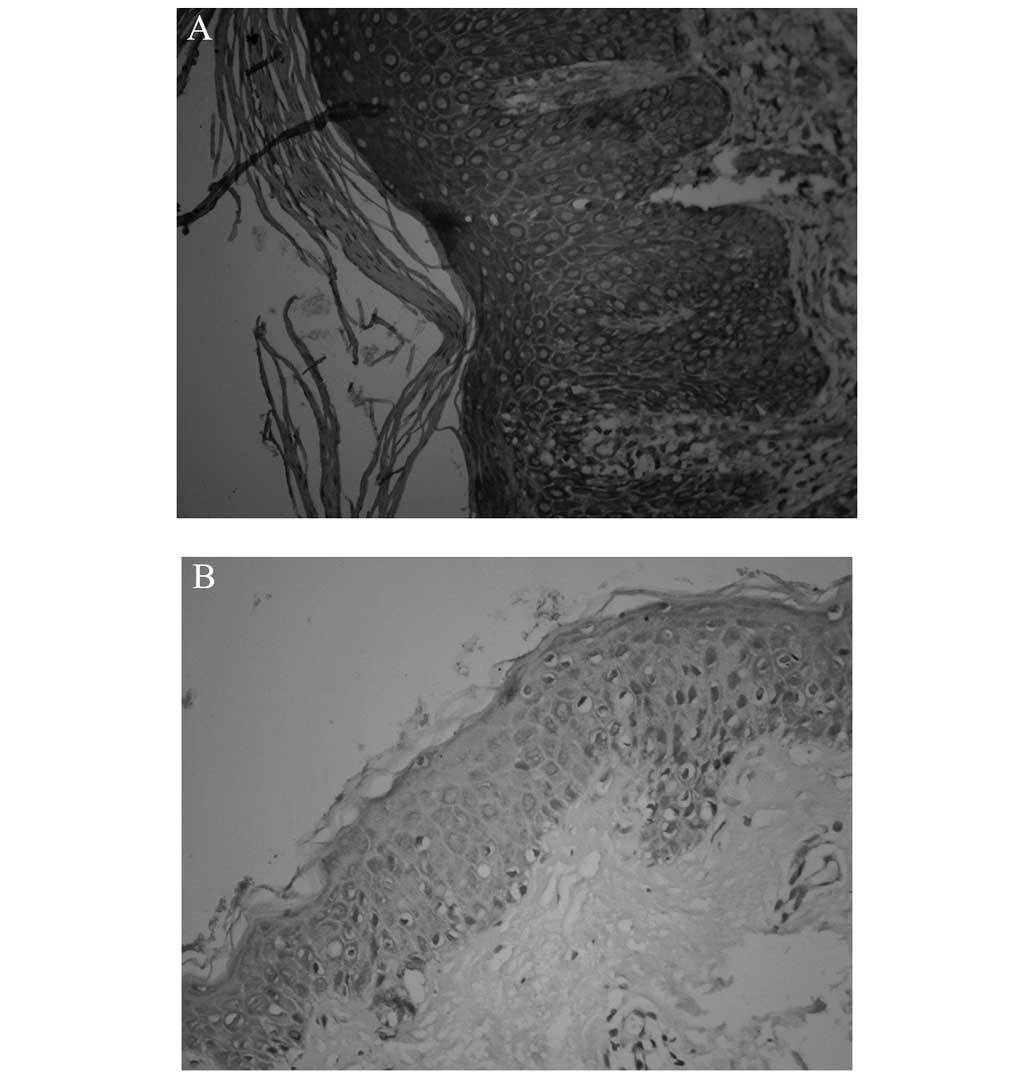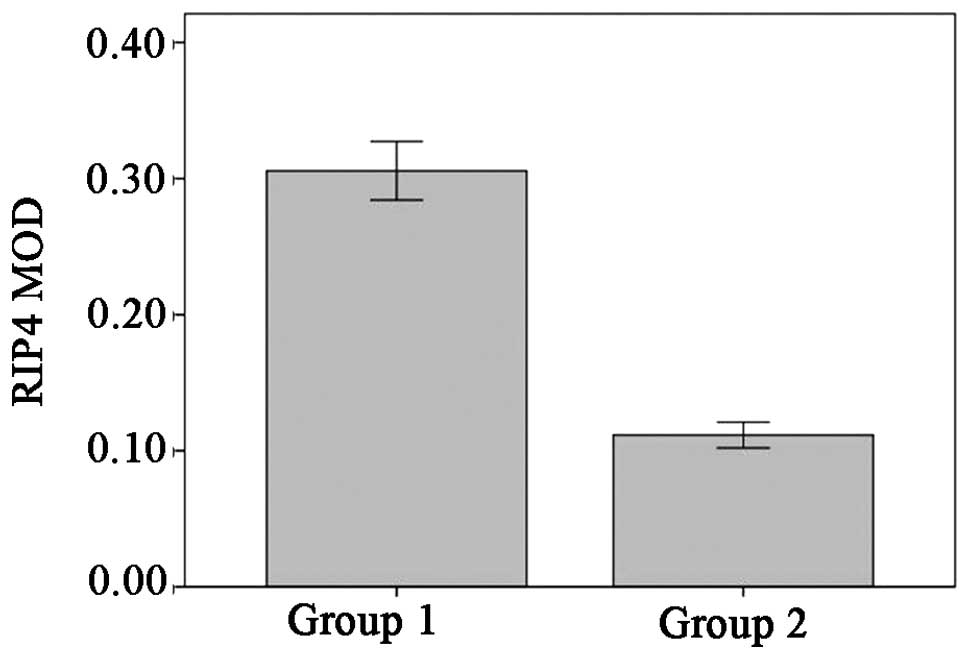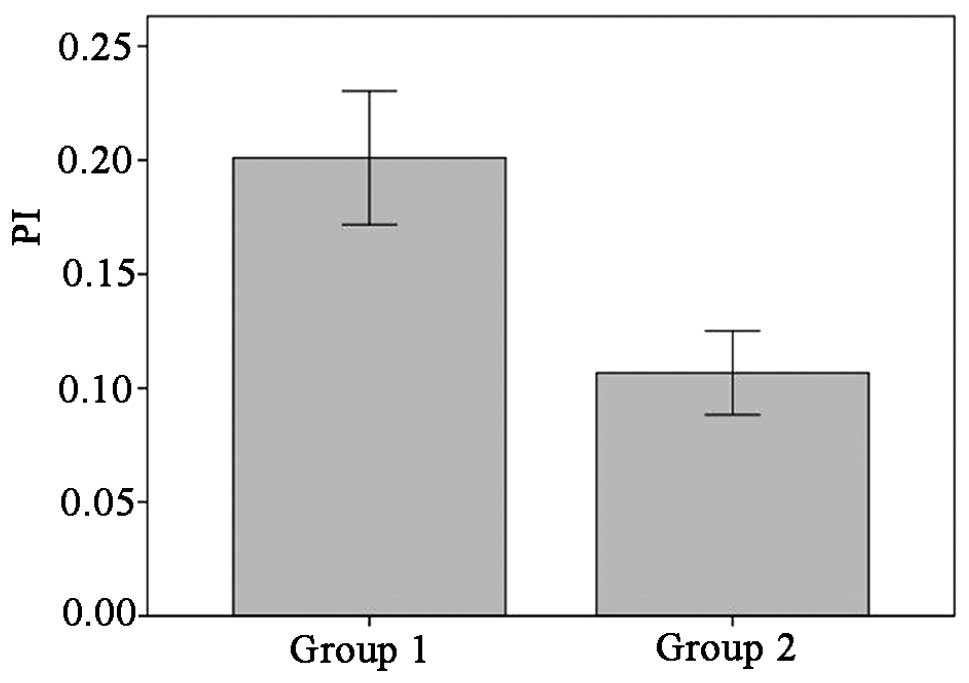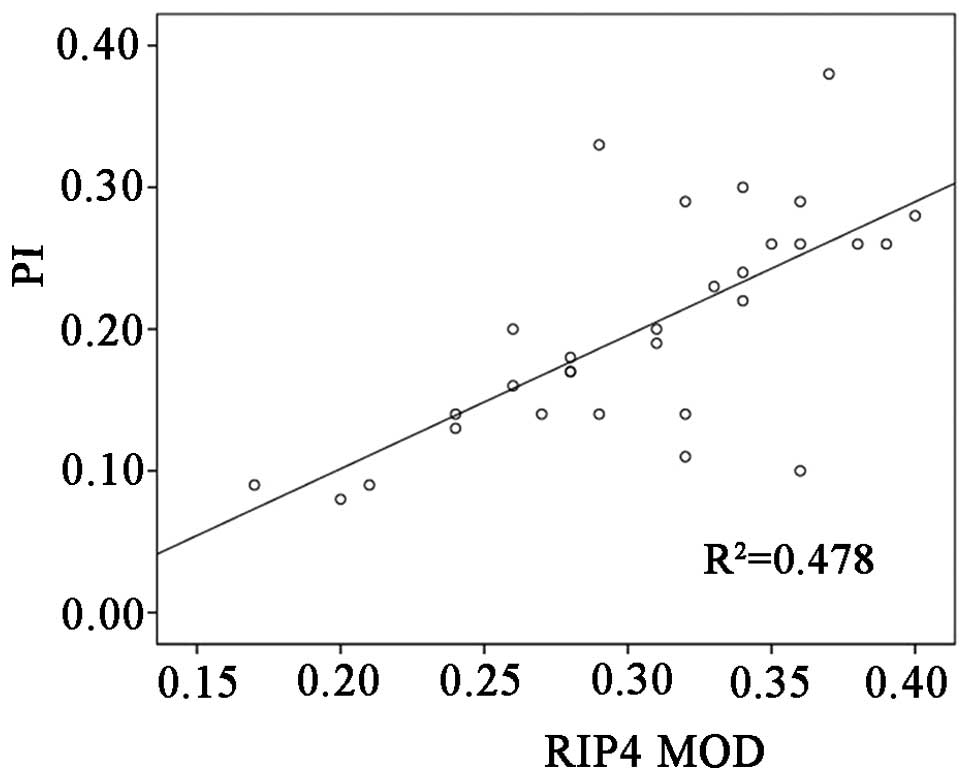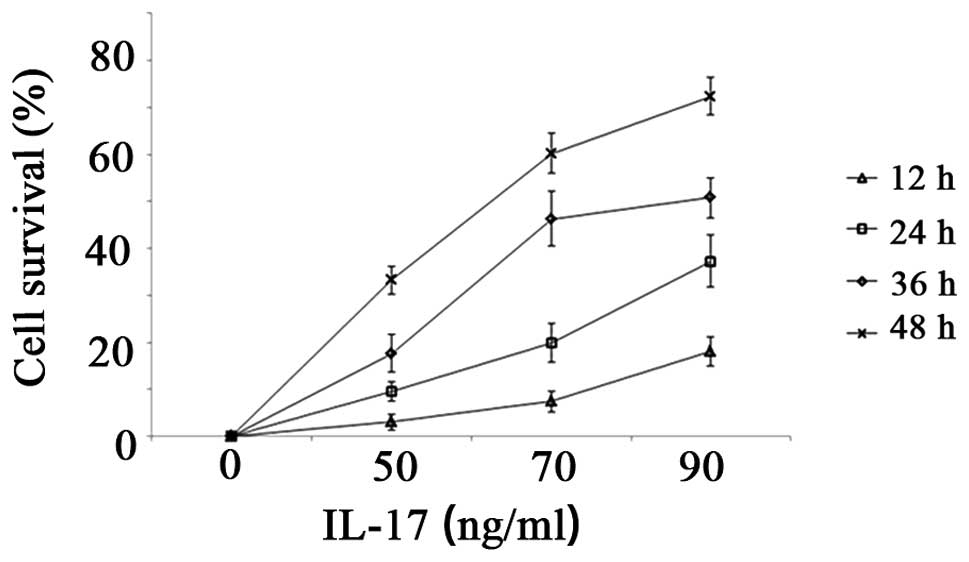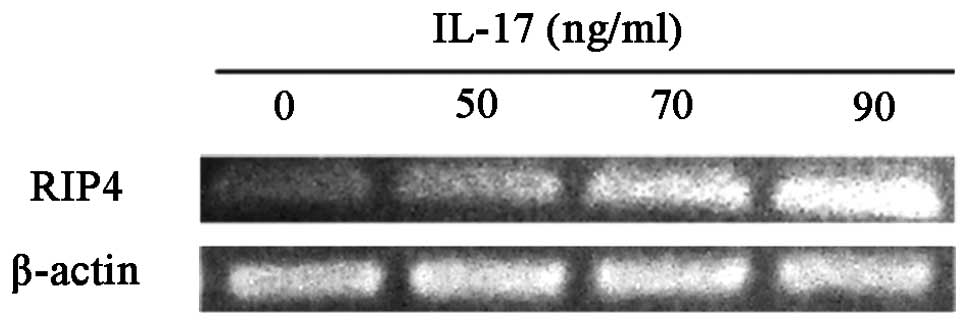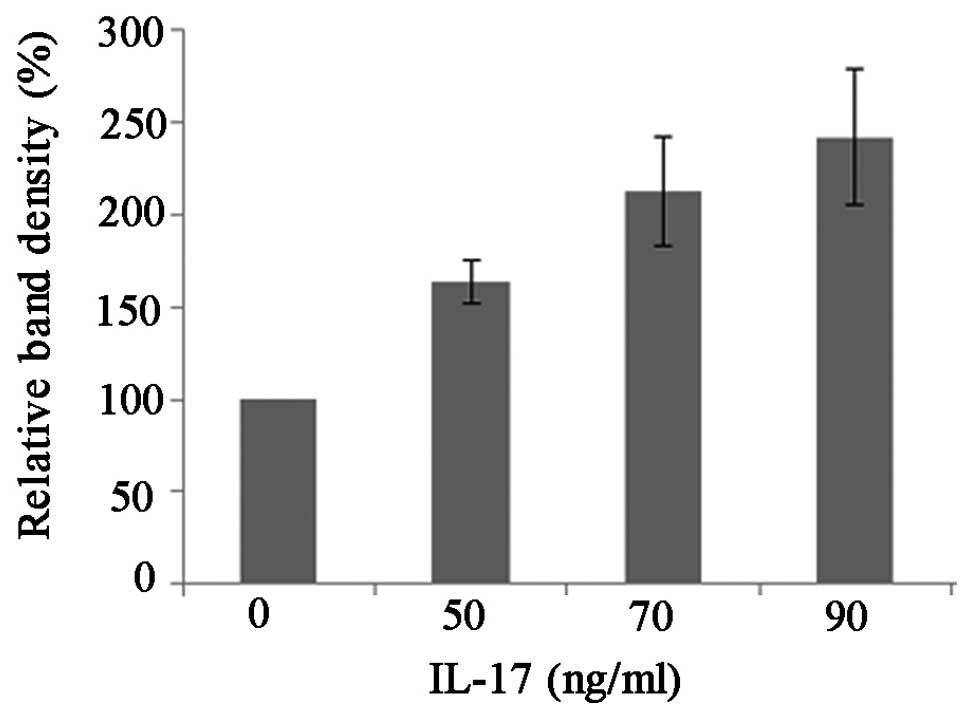Effect of interleukin-17 on receptor-interacting protein 4 expression and keratinocyte proliferation
- Authors:
- Published online on: May 7, 2015 https://doi.org/10.3892/etm.2015.2478
- Pages: 374-378
Abstract
Introduction
Psoriasis vulgaris is a common chronic inflammatory skin disease marked by the hyperproliferation of keratinocytes and infiltration of inflammatory cells. Although its pathogenesis has not been not fully elucidated, the condition is generally recognized as a polygenic disease resulting from a dysregulated interplay between hereditary and environmental factors, which gives rise to the hyperproliferative epidermis and altered differentiation through an immune-mediated common pathway. Immune dysfunction plays a vital role in the pathogenic progression of psoriasis vulgaris (1,2). T cells comprise the majority of the immune response cells in the lesions. A large number of T-helper (Th) cells can be found infiltrating the inflammatory reaction area, and one pathway that is important in psoriasis is the role of the Th17/interleukin-17 (IL-17) dysregulation (3–5). Th17 cells are a T-cell subset distinct from both Th1 and Th2 cells. IL-17, which is predominantly produced by Th17 cells, has been implicated in the pathogenesis of psoriasis vulgaris (6–8).
Receptor-interacting protein 4 (RIP4), as a novel member of the RIP kinase family, activates mitogen-activated protein kinases (MAPKs) and nuclear factor κ-light-chain-enhancer of activated B cells (NF-κB) during the proliferation, differentiation, apoptosis, inflammation and immune response of keratinocytes (9,10). The present study aims to investigate the role of RIP4 in psoriasis vulgaris through the use of immunohistochemistry to examine the RIP4 expression in the condition, and by detecting the mRNA and protein levels of RIP4 in a human immortal keratinocyte cell line, HaCaT, following stimulation of the cells with graded IL-17 concentrations.
Materials and methods
Patients and skin biopsies
Thirty psoriatic biopsies were obtained from 15 male and 15 female patients (mean age, 27.96±8.64 years; range, 19–52 years) who had been diagnosed with psoriasis vulgaris in Qilu Hospital (Jinan, China) and who had not received any local or systemic treatment since the latest attack of the disease. Non-lesion biopsies, acquired from 30 age- and gender-matched healthy individuals, served as controls. All participants were negative for systemic disease and gave their informed consent prior to biopsy. The study received approval from the Ethics Committee of Qilu Hospital (no. QL2009019). The specimens were fixed in 10% neutral formaldehyde immediately subsequent to their collection.
Immunohistochemistry
Paraffin-embedded 10% neutral formaldehyde-fixed tissues were sectioned continuously at 3 µm, deparaffinized with xylene and rehydrated in a graded alcohol series. For antigen retrieval, the deparaffinized sections in 1 mM EDTA buffer (pH=9.0) were heated at 120°C for 5 min and cooled slowly to room temperature. In order to prevent nonspecific background staining, the slices were blocked with goat serum following the quenching of endogenous peroxidase activity with 3% H2O2 solution. Polyclonal rabbit anti-human RIP4 antibody (cat. no. ZA-0502; Santa Cruz Biotechnology, Inc., Santa Cruz, CA, USA), at a dilution of 1:100, and a ready-to-use anti-Ki-67 monoclonal antibody (ZSGB-Bio, Beijing, China) were applied to the sections at 37°C for 1 h, prior to the use of the PV-6000 polymer detection system (ZSGB-Bio) according to the manufacturer's instructions. 3,3′-Diaminobenzidine (ZSGB-Bio) was applied to visualize the antibody under a microscope, following which the sections were counterstained with Harris's hematoxylin. The slices were mounted with neural gum and images were captured using the ToupCam microscope camera system (Hangzhou ToupTek Photonics Co., Ltd., Hangzhou, China).
Assessment of immunohistochemistry
Cells were considered to be RIP4- and Ki-67-positive when yellow to brown granules appeared in the cytoplasm or nucleus of the keratinocytes, respectively. The proliferation index was calculated as a percentage by dividing the number of Ki-67-positive cells by the total number of epidermal cells (basal and suprabasal). Five high-power fields (x400 magnification) were counted in each sample.
Cell culture
Immortalized human keratinocyte HaCaT cells were obtained commercially from the American Type Culture Collection (Manassas, VA, USA) and frozen in our lab. The HaCaT cells were thawed using a routine method and grown in Dulbecco's modified Eagle's medium (Gibco-BRL, Grand Island, NY, USA) supplemented with 10% (vol/vol) fetal bovine serum, 100 U/ml penicillin and 100 µg/ml streptomycin in a humidified atmosphere containing 5% CO2 at 37°C. For the subcultures, the cells were disaggregated with 0.25% trypsin/0.02% EDTA (1:1) solution and split at a ratio of 1:2 every 2 to 3 days, prior to inoculation into 12-well plates at a concentration of 1×105 cells/ml. HaCaT cells at 60–70% confluence were stimulated with IL-17 (50, 70 and 90 ng/ml; ProSpec-Tany TechnoGene, Ltd., Rehovot, Israel) for RNA isolation or western blotting. The control group cells were processed in parallel using Dulbecco's modified Eagle's medium without IL-17.
Cell counting kit-8 (CCK-8) assay
The CCK-8 assay (Dojindo Molecular Technologies, Inc., Kumamoto, Japan) was adopted to evaluate cell viability. Cells (5×103/ml) in the logarithmic phase were inoculated in 96-well plates with 100 µl normal growth medium containing 10% fetal calf serum. After 24 h, the medium was changed to serum-free medium. When the cell reached ~70% confluence, various doses of IL-17 (50, 70 and 90 ng/ml) in serum-free medium were added. A total of 10 µl CCK-8 was added to each well after 12, 24, 36 and 48 h incubation with IL-17, prior to further incubation for 2 h at 37°C. A microplate reader (Varioskan™ Flash; Thermo Fisher Scientific, Inc., Waltham, MA, USA) was applied to measure the optical density (OD) of each well at 450 nm. The cell viability (percentage of control) is expressed as the percentage of (ODtest-ODblank)/(ODcontrol-ODblank).
Reverse-transcription (RT)-semiquantitative polymerase chain reaction (PCR)
Total RNA was isolated from the cells 48 h after stimulation with IL-17 using RNAiso Plus [Takara Biotechnology (Dalian) Co., Ltd., Dalian, China] in accordance with the manufacturer's instructions and quantified spectrophotometrically at 260 nm. A total of 1 µg RNA was converted in cDNA using oligo (dT) primers and then amplified with a Power RT kit (BioTeke, Beijing, China). The PCR was performed in a total reaction volume of 50 µl: 25 µl 2X PCR Mix (BioTeke), 2.5 µl forward and reverse primer, 10 µl templates and 10 µl sterile H2O. The mixture underwent predenaturation for 5 min at 95°C and was then subjected to 35 cycles of 95°C for 1 min, 60°C for 45 sec and 72°C for 45 sec, and finally 72°C for 10 min. The specific primer sets (Table I) were commercially synthesized by Shanghai Sangon Biotechnology Co., Ltd. (Shanghai, China). The amplified DNA fragments were analyzed using 2% agarose gel electrophoresis. The expected fragment length was 384 bp for RIP4 and 447 bp for β-actin. Ethidium bromide-stained PCR products were visualized using an ultraviolet transilluminator (Tanon™ 2500R; Tanon Science & Technology Co., Ltd., Shanghai, China), and the gray value of the DNA bands was simultaneously determined using an automatic image analyzer with the following formula: Relative gray value = RIP4/β-actin.
Western blot analysis
HaCaT cells were dissolved in lysis buffer (cell lysis buffer for western and immunoprecipitation; Beyotime Institute of Biotechnology, Haimen, China) containing 1 mM phenylmethanesulfonyl fluoride (Beyotime Institute of Biotechnology). The mixture was centrifuged for 5 min at 12,000 × g and the bicinchoninic acid (BCA) assay method (Enhanced BCA Protein Assay kit; Beyotime Institute of Biotechnology) was utilized to quantify the total protein in the supernatant. A total of 30 µg protein from the cell lysate was solubilized in loading buffer and subjected to sodium dodecyl sulfate-polyacrylamide gel electrophoresis on a 10% acrylamide gel, prior to being electrotransferred onto polyvinylidene difluoride (PVDF) membranes. Following blocking with 5% skimmed milk at room temperature for 1 h, the PVDF membranes were incubated overnight at 4°C with polyclonal rabbit anti-human RIP4 antibody at a dilution of 1:400 (sc-83320; Beijing Biosynthesis Biotechnology Co., Ltd., Beijing, China) or with mouse anti-human anti-β-actin antibody (Santa Cruz Biotechnology, Inc.) at a dilution of 1:1,000. The membranes were then thoroughly washed with 0.01 M Tris-buffered saline containing 0.1% Tween 20 and incubated with horseradish peroxidase-labeled goat-anti-rabbit or goat-anti-mouse immunoglobulin G (heavy- and light-chain) antibody (EarthOx Life Sciences, Millbrae, CA, USA) at a dilution of 1:1,000 at room temperature for 1 h. A standard enhanced chemiluminescence (Shanghai Sangon Biotechnology Co., Ltd.) reaction was performed according to the manufacturer's instructions, and densitometric analysis of the band intensity was conducted using a chemiluminescence imaging analysis system (Tanon 5000; Tanon Science & Technology Co., Ltd.). Relative expression was measured by dividing the gray value of RIP4 by that of β-actin. High gray values represented low expression.
Statistical analysis
All statistical analysis was carried out using the SPSS 17.0 software package (SPSS, Inc., Chicago, IL, USA), and data are presented as the mean ± standard error of the mean. The Student's t-test was performed for the comparison of the results, and the correlation between RIP4 expression and the proliferation index was examined using Pearson's correlation analysis.
Results
RIP4 is mainly expressed in the cytosol and nuclei of keratinocytes and shows an evident upregulation in psoriatic lesions
In healthy skin, RIP4 was found predominantly in the basal layer of the epidermis; by contrast, the expression in the psoriatic lesions was concentrated in the basal and spinous layers, in the cytoplasm and nuclei of the cells. Analysis of the OD showed the mean OD (MOD) of RIP4 in the healthy controls to be 0.11±0.03, compared with 0.30±0.05 in the psoriasis vulgaris lesions. This revealed a statistically significant upregulation in the psoriatic lesions (t=7.71, P<0.01) (Figs. 1 and 2).
RIP4 expression in psoriatic skin is associated with keratinocyte proliferation
In the healthy control skin, Ki-67-positive cells only appeared sporadically in the basal layer. By contrast, Ki-67-positive cells in the psoriatic specimens were distributed in not only the basal layer but also the middle and lower parts of the rete ridges of the lesional epidermis. The proliferation index of the psoriatic lesions was 20.01±7.90%, while that of the healthy control skin was 10.67±4.92%; this suggested that the Ki-67 expression in the psoriatic lesions was significantly higher than that in the healthy control skin (t=4.535, P<0.05) (Fig 3). In addition, Pearson's correlation analysis demonstrated a significantly positive correlation between the RIP4 MOD and the proliferation index, which indicated that a high level of RIP4 expression led to the active proliferation of keratinocytes in the epidermis (r=0.692, P<0.01) (Fig. 4).
Promotion of HaCaT cell proliferation and significant upregulation of RIP4 following IL-17 stimulation
To further investigate the role of RIP4 in psoriasis, an immortalized line of human epidermal keratinocytes, HaCaT, which has been extensively adopted as an in vitro model for studies of psoriasis, was utilized. The CCK-8 assay performed 12, 24, 36 and 48 h after culture in medium containing IL-17 revealed that IL-17 at concentrations of between 50 and 90 ng/ml had a marked stimulatory effect on HaCaT cell proliferation, acting in a dose- and time-dependent manner. Increased concentrations of IL-17 resulted in higher proliferation rates (Fig. 5).
RT-semi-quantitative PCR and western blot analyses were applied to study the change in RIP4 mRNA and protein expression, respectively, following exposure to IL-17. The RIP4 mRNA and protein were isolated 48 h after the stimulation of the cells with 50, 70 and 90 ng/ml IL-17 and subjected to RT-semi-quantitative PCR or western blot analyses with β-actin as a housekeeping control. Compared with the control group, it was found that IL-17 dose-dependently induced a significant upregulation of RIP4 expression at both the mRNA (t50=5.091, P50=0.036; t70=7.022, P70=0.020; t90=18.621, P90=0.003) and protein (t50=9.076, P50=0.012; t70=6.600, P70=0.022; t90=6.650, P90=0.022) levels (Figs. 6–9).
Discussion
Psoriasis vulgaris is a common chronic skin disease in which a thicker epidermis, excessive keratinocyte proliferation and parakeratosis, accompanied by extensive inflammatory cell infiltration, can be observed (9). It is generally believed that the abnormal keratinocyte proliferation and differentiation occurs as a result of T cells recognizing a previously unidentified self-antigen, giving rise to an immune response (10,11). To date, considerable evidence has revealed the aggregation of Th17 cells and the upregulation of IL-17 and IL-17 receptor (IL-17R) in psoriatic lesions (12,13). Furthermore, the application of agents that act to deplete the number of T cells in skin lesions and the administration of monoclonal anti-IL-17 antibodies have been shown to lead to the clinical and histopathological remission of psoriasis vulgaris, thereby providing direct evidence that the IL-17-induced changes in the proliferation and differentiation of keratinocytes play a role in the pathogenesis of psoriasis vulgaris (12–16).
The RIP kinase family comprises a group of specific serine/threonine kinases that are crucial mediators of multiple signal transduction processes, which lead to the activation of NF-κB and MAPKs (17). RIP4, a novel member of the RIP kinase family, was initially identified as a kinase that interacts with an isoform of the protein kinase C (PKC) family, PKCδ. RIP4 shares a homologous N-terminal kinase domain with other RIP kinases (~40% identity) and is characterized by a C-terminal region harboring 11 ankyrin repeats. RIP4 is widespread in various tissues and cells throughout the body, including the liver, kidney, brain, heart, lung, skeletal muscles and skin. Overexpression of RIP4 in 293T cells results in the activation of NF-κB and the c-Jun N-terminal kinase (JNK) signaling pathway in a dose-dependent manner (17). Previous studies (18–20) have demonstrated that RIP4 is required during epidermal differentiation and cell proliferation in mice, based on the fact that epidermal dysplasia was observed in RIP4-deficient mice. The outermost cornified layers were absent in RIP4−/− skin and were replaced by a thick layer of flattened, parakeratotic cells with abnormal expression of the proteins that characteristically mark the specific epidermal layers. Furthermore, marked hyperplasia of the spinous and granular layers was observed, indicating that RIP4 is a crucial factor in the embryonic development of the epidermis (18). The strong downregulation of RIP4 following skin injury has indicated it to be an important regulator of re-epithelialization following injury (21). In addition, K14-RIP4 mice are sensitive to cutaneous inflammation with markedly overexpressed RIP4 (19). Thus, we suggest that RIP4 could be a key element in the regulation of keratinocyte proliferation and differentiation and the inflammatory response.
RIP4 activates NF-κB by inducing inhibitor of κB phosphorylation, which requires an active kinase domain. Similar to NF-κB activation, RIP4-mediated JNK signal initiation depends on the presence of the kinase domain (22,23). Elevated levels of NF-κB and JNK can be observed in psoriatic lesions, and drugs aiming to inactivate NF-κB and block the JNK signaling pathway appear to be of satisfactory efficacy (24–26). It is speculated that the RIP4-mediated overactivation of NF-κB and JNK may contribute to such pathological processes as active keratinocyte proliferation.
IL-17 is one of the most important inflammatory factors in psoriasis. In the present study, the elevated proliferation rate of HaCaT cells and the higher levels of RIP4 expression were shown to be enhanced by stimulation with an increasing concentration of IL-17. Furthermore, the RIP4 protein level, which was shown to be positively correlated with the proliferation index, was notably upregulated in the psoriatic lesions compared with the healthy control skin. It could thus be inferred that RIP4 is a possible downstream molecule of IL-17.
Interacting with IL-17R on the surface of keratinocytes, IL-17 produces proinflammatory and proliferation-regulatory effects by means of activating NF-κB and the JNK signaling pathway, in which RIP4 is directly involved (27). In combination, these data suggest that epidermal hyperproliferation and prosoplasia in psoriasis vulgaris could be the result of overexpressed RIP4, induced by the activation of NF-κB and the JNK signaling pathway by elevated IL-17. In conclusion, IL-17, as an inflammatory factor, could lead to the upregulation of RIP4 in keratinocytes, and the IL-17/RIP4 axis may play a role in the epidermal hyperplasia of psoriasis vulgaris.
Acknowledgements
This study was supported by the 2010 National Science Foundation (grant no. 81071291).
References
|
Ariza ME, Williams MV and Wong HK: Targeting IL-17 in psoriasis: From cutaneous immunobiology to clinical application. Clin Immunol. 146:131–139. 2013. View Article : Google Scholar : PubMed/NCBI | |
|
Bowcock AM and Krueger JG: Getting under the skin: The immunogenetics of psoriasis. Nat Rev Immunol. 5:699–711. 2005. View Article : Google Scholar : PubMed/NCBI | |
|
Gudjonsson JE, Johnston A, Sigmundsdottir H and Valdimarsson H: Immunopathogenic mechanisms in psoriasis. Clin Exp Immunol. 135:1–8. 2004. View Article : Google Scholar : PubMed/NCBI | |
|
Valdimarsson H, Bake BS, Jónsdótdr I and Fry L: Psoriasis: A disease of abnormal Keratinocyte proliferation induced by T lymphocytes. Immunol Today. 7:256–259. 1986. View Article : Google Scholar : PubMed/NCBI | |
|
Ghoreschi K, Weigert C and Röcken M: Immunopathogenesis and role of T cells in psoriasis. Clin Dermatol. 25:574–580. 2007. View Article : Google Scholar : PubMed/NCBI | |
|
Di Cesare A, Di Meglio P and Nestle FO: The IL-23/Th17 axis in the immunopathogenesis of psoriasis. J Invest Dermatol. 129:1339–1350. 2009. View Article : Google Scholar : PubMed/NCBI | |
|
Blauvelt A: T-helper 17 cells in psoriatic plaques and additional genetic links between IL-23 and psoriasis. J Invest Dermatol. 128:1064–1067. 2008. View Article : Google Scholar : PubMed/NCBI | |
|
Chiu HY, Cheng YP and Tsai TF: T helper type 17 in psoriasis: From basic immunology to clinical practice. Dermatol Sin. 30:136–141. 2012. View Article : Google Scholar | |
|
Meylan E and Tschopp J: The RIP kinases: Crucial integrators of cellular stress. Trends Biochem Sci. 30:151–159. 2005. View Article : Google Scholar : PubMed/NCBI | |
|
McKay IA and Leigh IM: Altered keratinocyte growth and differentiation in psoriasis. Clin Dermatol. 13:105–114. 1995. View Article : Google Scholar : PubMed/NCBI | |
|
Tschachler E: Psoriasis: The epidermal component. Clin Dermatol. 25:589–595. 2007. View Article : Google Scholar : PubMed/NCBI | |
|
Lowes MA, Kikuchi T, Fuentes-Duculan J, et al: Psoriasis vulgaris lesions contain discrete populations of Th1 and Th17 T cells. J Invest Dermatol. 128:1207–1211. 2008. View Article : Google Scholar : PubMed/NCBI | |
|
Zhang L, Yang XQ, Cheng J, et al: Increased Th17 cells are accompanied by FoxP3(+) Treg cell accumulation and correlated with psoriasis disease severity. Clin Immunol. 135:108–117. 2010. View Article : Google Scholar : PubMed/NCBI | |
|
Krueger JG, Fretzin S, Suárez-Fariñas M, et al: IL-17A is essential for cell activation and inflammatory gene circuits in subjects with psoriasis. J Allergy Clin Immunol. 130:145–154. 2012. View Article : Google Scholar : PubMed/NCBI | |
|
Leonardi C, Matheson R, Zachariae C, et al: Anti-interleukin-17 monoclonal antibody ixekizumab in chronic plaque psoriasis. New Engl J Med. 366:1190–1199. 2012. View Article : Google Scholar : PubMed/NCBI | |
|
Papp KA, Leonardi C, Menter A, et al: Brodalumab, an anti-interleukin-17-receptor antibody for psoriasis. New Engl J Med. 366:1181–1189. 2012. View Article : Google Scholar : PubMed/NCBI | |
|
Meylan E, Martinon F, Thome M, et al: RIP4 (DIK/PKK), a novel member of the RIP kinase family, activates NF-kappa B and is processed during apoptosis. EMBO Rep. 3:1201–1208. 2002. View Article : Google Scholar : PubMed/NCBI | |
|
Holland PM, Willis CR, Kanaly S, et al: RIP4 is an ankyrin repeat-containing kinase essential for keratinocyte differentiation. Curr Biol. 12:1424–1428. 2002. View Article : Google Scholar : PubMed/NCBI | |
|
Rountree RB, Willis CR, Dinh H, et al: RIP4 regulates epidermal differentiation and cutaneous inflammation. J Invest Dermatol. 130:102–112. 2010. View Article : Google Scholar : PubMed/NCBI | |
|
Adams S and Munz B: RIP4 is a target of multiple signal transduction pathways in keratinocytes: Implications for epidermal differentiation and cutaneous wound repair. Exp Cell Res. 316:126–137. 2010. View Article : Google Scholar : PubMed/NCBI | |
|
Adams S, Pankow S, Werner S and Munz B: Regulation of NF-kappaB activity and keratinocyte differentiation by the RIP4 protein: Implications for cutaneous wound repair. J Invest Dermatol. 127:538–544. 2007. View Article : Google Scholar : PubMed/NCBI | |
|
Bell S, Degitz K, Quirling M, et al: Involvement of NF-kappaB signalling in skin physiology and disease. Cell Signal. 15:1–7. 2003. View Article : Google Scholar : PubMed/NCBI | |
|
Lizzul PF, Aphale A, Malaviya R, et al: Differential expression of phosphorylated NF-kappaB/RelA in normal and psoriatic epidermis and downregulation of NF-kappaB in response to treatment with etanercept. J Invest Dermatol. 124:1275–1283. 2005. View Article : Google Scholar : PubMed/NCBI | |
|
Gazel A, Banno T, Walsh R and Blumenberg M: Inhibition of JNK promotes differentiation of epidermal keratinocytes. J Biol Chem. 281:20530–20541. 2006. View Article : Google Scholar : PubMed/NCBI | |
|
Kim HR, Cho ML, Kim KW, et al: Up-regulation of IL-23p19 expression in rheumatoid arthritis synovial fibroblasts by IL-17 through PI3-kinase-, NF-kappaB- and p38 MAPK-dependent signalling pathways. Rheumatology (Oxford). 46:57–64. 2007. View Article : Google Scholar : PubMed/NCBI | |
|
Awane M, Andres PG, Li DJ and Reinecker HC: NF-kappa B-inducing kinase is a common mediator of IL-17-, TNF-alpha-, and IL-1 beta-induced chemokine promoter activation in intestinal epithelial cells. J Immunol. 162:5337–5344. 1999.PubMed/NCBI | |
|
Dong C: Diversification of T-helper-cell lineages: Finding the family root of IL-17-producing cells. Nat Rev Immunol. 6:329–333. 2006. View Article : Google Scholar : PubMed/NCBI |



